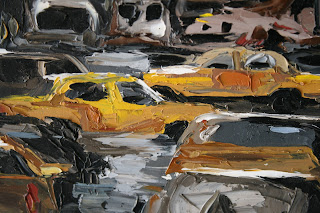The importance of details can be dissected in writing, parenting, relationships, business, politics and everywhere in between. In every aspect of my life the magic happens in the details. It can be a quick "Hello" and smile from a stranger or Lucky Charms in bed with my kids. The bulk of life is pretty mundane for most of us; go for a run, pick up the house, go to work, groceries, fold the laundry, pay the bills etc. But small and simple things make the biggest difference.
Art is no exception. The details are those quiet things that speak to each of us. For some of us it's the lighting. For others it's the dynamics of the color palette or the subject or style of a work of art. For me it's all about the texture. I love messy texture. For those of you that read my blog regularly, this isn't surprise.
I'm a texture junky what can I say?
 I was once asked what knife painting is like. After some thought, I realized it's a lot like frosting a cake with really flexible frosting. If you can frost a cake then you can paint with a knife. Give it a try but here's some helpful hints for painting your own palette knife painting:
I was once asked what knife painting is like. After some thought, I realized it's a lot like frosting a cake with really flexible frosting. If you can frost a cake then you can paint with a knife. Give it a try but here's some helpful hints for painting your own palette knife painting:
I'm a texture junky what can I say?
Recently, I've been experimenting in the studio with textures and even went back to some older inventory to review textures. I'm loving the way the round knife creates the depth of a flower petal. If you were close enough you could pinch the edges with your fingers. I also love how easy it is to create water with a knife. The reflection and movement of water jumps off the canvas almost effortlessly with a straight edge knife. The puff of a cloud or the gradient in the sky is just a stroke and the direction you hold the knife in your hand.
 I was once asked what knife painting is like. After some thought, I realized it's a lot like frosting a cake with really flexible frosting. If you can frost a cake then you can paint with a knife. Give it a try but here's some helpful hints for painting your own palette knife painting:
I was once asked what knife painting is like. After some thought, I realized it's a lot like frosting a cake with really flexible frosting. If you can frost a cake then you can paint with a knife. Give it a try but here's some helpful hints for painting your own palette knife painting:1. Choose the right size.
Your going to use A LOT of paint. Start with a small canvas if you don't have a large amount of paint. The bigger the canvas the more paint you're going to use.
2. Variety of knives.
When you're trying to decide what kind of knife to buy remember to get several different varieties. Rounded edge are great for leafs and flowers. Angled edges are good for straight lines and smaller knives are great for precision and on a smaller canvas.
3. Paper Towels.
Mix. Load. Apply x 2. Wipe.
Get a bunch of paper towels. I typically go through 2 - 3 rolls of paper towels per painting. You usually only get 2 - 3 swipes of the knife and then have to wipe off the paint and re-load. Less is more with knife paintings. You'll end up with mud if you keep messing with it.
4. Impasto Gel.
To stretch the paint and aid the drying process get an impasto gel but make sure you paint in a vented room because it's really smelly.
5. Trust your placement.
The first placement is usually right. Don't second guess yourself. Study the lines you're trying to create first and then apply the paint.
6. Rock some good tunes.
Music is a must. Just sayin...
Good luck!!
If you have any thoughts please leave a comment!
*How to paint with a palette knife, tutorial, guide, details, close up, texture
*How to paint with a palette knife, tutorial, guide, details, close up, texture


No comments:
Post a Comment